Topic 3: Misc. Questions
You develop a custom question answering project in Azure Cognitive Service for
Language. The project will be used by a chatbot. You need to configure the project to
engage in multi-turn conversations. What should you do?
A.
Add follow-up prompts
B.
Enable active learning.
C.
Add alternate questions
D.
Enable chit-chat
Enable chit-chat
You plan to build a chatbot to support task tracking.
You create a Language Understanding service named lu1.
You need to build a Language Understanding model to integrate into the chatbot. The solution must minimize development time to build the model.
Which four actions should you perform in sequence? To answer, move the appropriate
actions from the list of actions to the answer area and arrange them in the correct order.
(Choose four.)
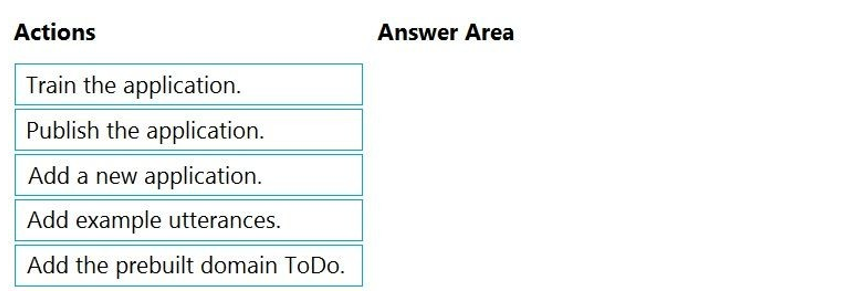

Explanation:
1. Add a new application
2. Add a prebuilt domain intent ToDo (it has already utterances so we can skip this step)
3. Train
4. Publish
You are designing a conversation flow to be used in a chatbot.
You need to test the conversation flow by using the Microsoft Bot Framework Emulator.
How should you complete the .chat file? To answer, select the appropriate options in the
answer area.
NOTE: Each correct selection is worth one point.
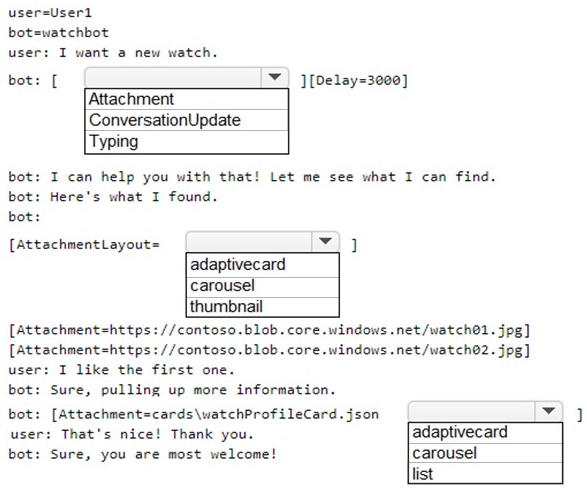
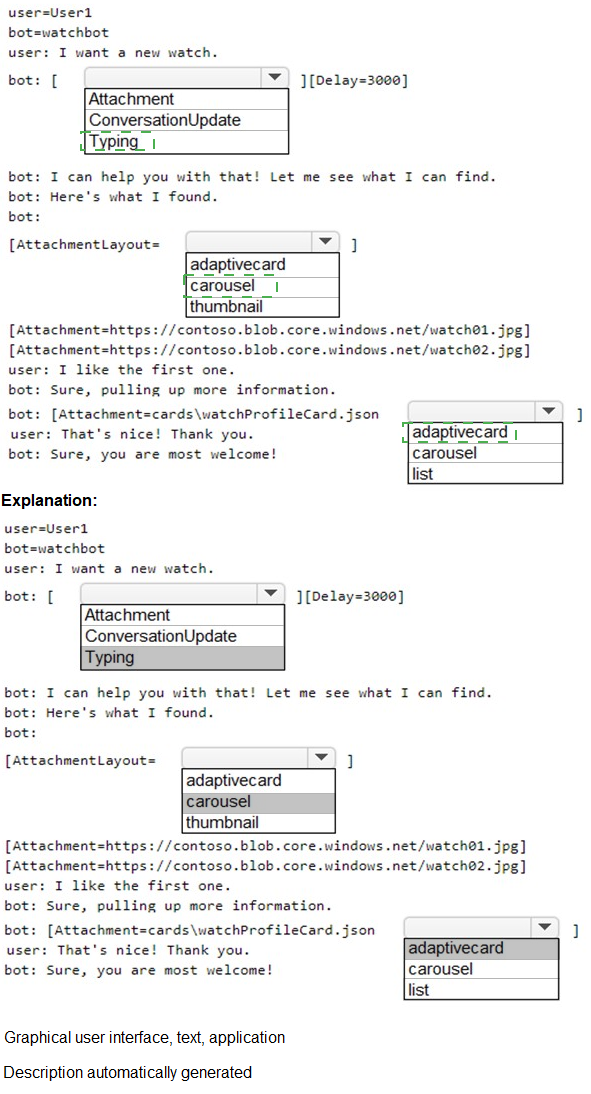
Match the Azure services to the appropriate locations in the architecture.
To answer, drag the appropriate service from the column on the left to its location on the
right. Each service may be used once, more than once, or not at all.
NOTE: Each correct match is worth one point.

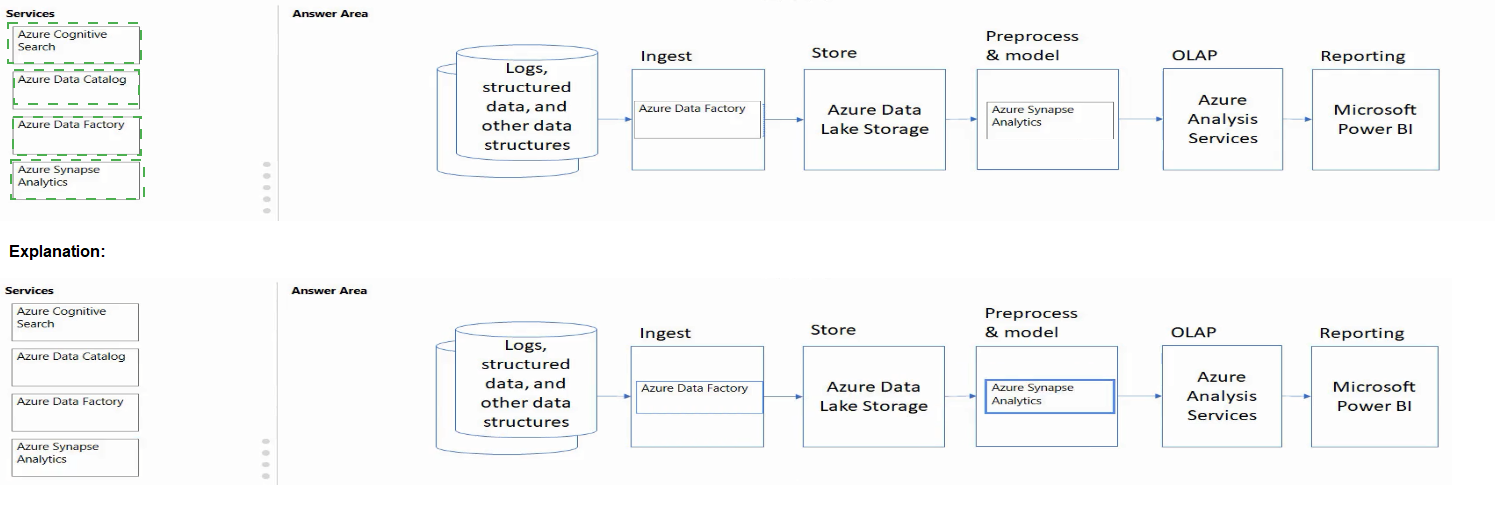
What is used to define a query in a stream processing jobs in Azure Stream Analytics?
A.
SQL
B.
XML
C.
YAML
D.
KOL
SQL
You have a Language Understanding resource named lu1.
You build and deploy an Azure bot named bot1 that uses lu1.
You need to ensure that bot1 adheres to the Microsoft responsible AI principle of
inclusiveness.
How should you extend bot1?
A.
Implement authentication for bot1
B.
Enable active learning for Iu1
C.
Host Iu1 in a container
D.
Add Direct Line Speech to bot1.
Add Direct Line Speech to bot1.
Explanation:
Inclusiveness: AI systems should empower everyone and engage people.
Direct Line Speech is a robust, end-to-end solution for creating a flexible, extensible voice
assistant. It is powered by the Bot Framework and its Direct Line Speech channel, that is
optimized for voice-in, voice-out interaction with bots.
Reference:
https://docs.microsoft.com/en-us/azure/cognitive-services/speech-service/direct-line-speech
You are reviewing the design of a chatbot. The chatbot includes a language generation file
that contains the following fragment.
# Greet(user)
- ${Greeting()}, ${user.name}
For each of the following statements, select Yes if the statement is true. Otherwise, select
No.
NOTE: Each correct selection is worth one point.

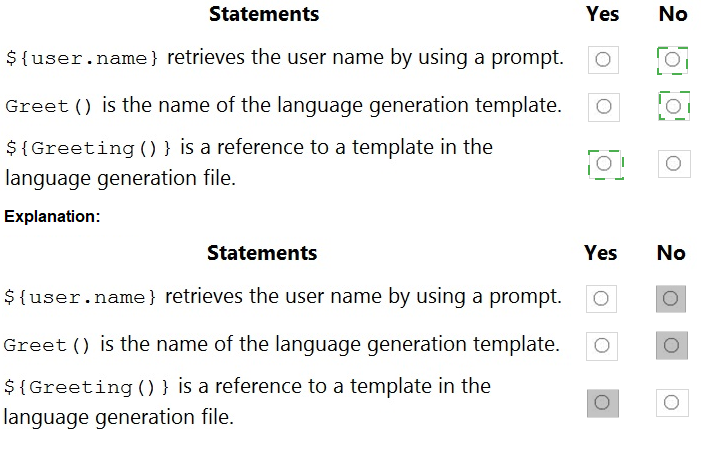
You are developing an application to recognize employees’ faces by using the Face
Recognition API. Images of the faces will be accessible from a URI endpoint.
The application has the following code.


Explanation:
A. True
B. True
C. True
B: see this example code from documentation that uses PersonGroup of size 10,000 :
https://docs.microsoft.com/en-us/azure/cognitive-services/face/face-api-how-to-topics/howto-
add-faces
the question wants to trick you into thinking you need to use a LargePersonGroup for a size
of 10,000 - but the documentation for it doesn't include this limitation or criteria:
https://docs.microsoft.com/en-us/azure/cognitive-services/face/face-api-how-to-topics/howto-
use-large-scale
You have the following data sources:
Finance: On-premises Microsoft SQL Server database
Sales: Azure Cosmos DB using the Core (SQL) API
Logs: Azure Table storage
HR: Azure SQL database
You need to ensure that you can search all the data by using the Azure Cognitive Search
REST API. What should you do?
A.
Configure multiple read replicas for the data in Sales.
B.
Mirror Finance to an Azure SQL database
C.
Migrate the data in Sales to the MongoDB API.
D.
Ingest the data in Logs into Azure Sentinel.
Mirror Finance to an Azure SQL database
Explanation:
On-premises Microsoft SQL Server database cannot be used as an index data source.
Note: Indexer in Azure Cognitive Search: : Automate aspects of an indexing operation by
configuring a data source and an indexer that you can schedule or run on demand. This
feature is supported for a limited number of data source types on Azure.
Indexers crawl data stores on Azure.
Azure Blob Storage
Azure Data Lake Storage Gen2 (in preview)
Azure Table Storage
Azure Cosmos DB
Azure SQL Database
SQL Managed Instance
SQL Server on Azure Virtual Machines
Reference:
https://docs.microsoft.com/en-us/azure/search/search-indexer-overview#supported-datasources
You need to build a chatbot that meets the following requirements:
Supports chit-chat, knowledge base, and multilingual models
Performs sentiment analysis on user messages
Selects the best language model automatically
What should you integrate into the chatbot?
A.
QnA Maker, Language Understanding, and Dispatch
B.
Translator, Speech, and Dispatch
C.
Language Understanding, Text Analytics, and QnA Maker
D.
Text Analytics, Translator, and Dispatch
Language Understanding, Text Analytics, and QnA Maker
Explanation:
Language Understanding: An AI service that allows users to interact with your applications,
bots, and IoT devices by using natural language.
QnA Maker is a cloud-based Natural Language Processing (NLP) service that allows you to
create a natural conversational layer over your data. It is used to find the most appropriate
answer for any input from your custom knowledge base (KB) of information.
Text Analytics: Mine insights in unstructured text using natural language processing
(NLP)—no machine learning expertise required. Gain a deeper understanding of customer
opinions with sentiment analysis. The Language Detection feature of the Azure Text
Analytics REST API evaluates text input
Reference:
https://azure.microsoft.com/en-us/services/cognitive-services/text-analytics/
https://docs.microsoft.com/en-us/azure/cognitive-services/qnamaker/overview/overview
You have a chatbot that was built by using the Microsoft Bot Framework. You need to
debug the chatbot endpoint remotely.
Which two tools should you install on a local computer? Each correct answer presents part
of the solution. (Choose two.)
NOTE: Each correct selection is worth one point.
A.
Fiddler
B.
Bot Framework Composer
C.
Bot Framework Emulator
D.
Bot Framework CLI
E.
ngrok
F.
nginx
Bot Framework Emulator
ngrok
Explanation:
Bot Framework Emulator is a desktop application that allows bot developers to test and
debug bots, either locally or remotely.
ngrok is a cross-platform application that "allows you to expose a web server running on
your local machine to the internet." Essentially, what we'll be doing is using ngrok to
forward messages from external channels on the web directly to our local machine to allow
debugging, as opposed to the standard messaging endpoint configured in the Azure portal.
Reference:
https://docs.microsoft.com/en-us/azure/bot-service/bot-service-debug-emulator
You need to create a new resource that will be used to perform sentiment analysis and
optical character recognition (OCR). The solution must meet the following requirements:
Use a single key and endpoint to access multiple services.
Consolidate billing for future services that you might use.
Support the use of Computer Vision in the future.
How should you complete the HTTP request to create the new resource? To answer, select
the appropriate options in the answer area.
NOTE: Each correct selection is worth one point.

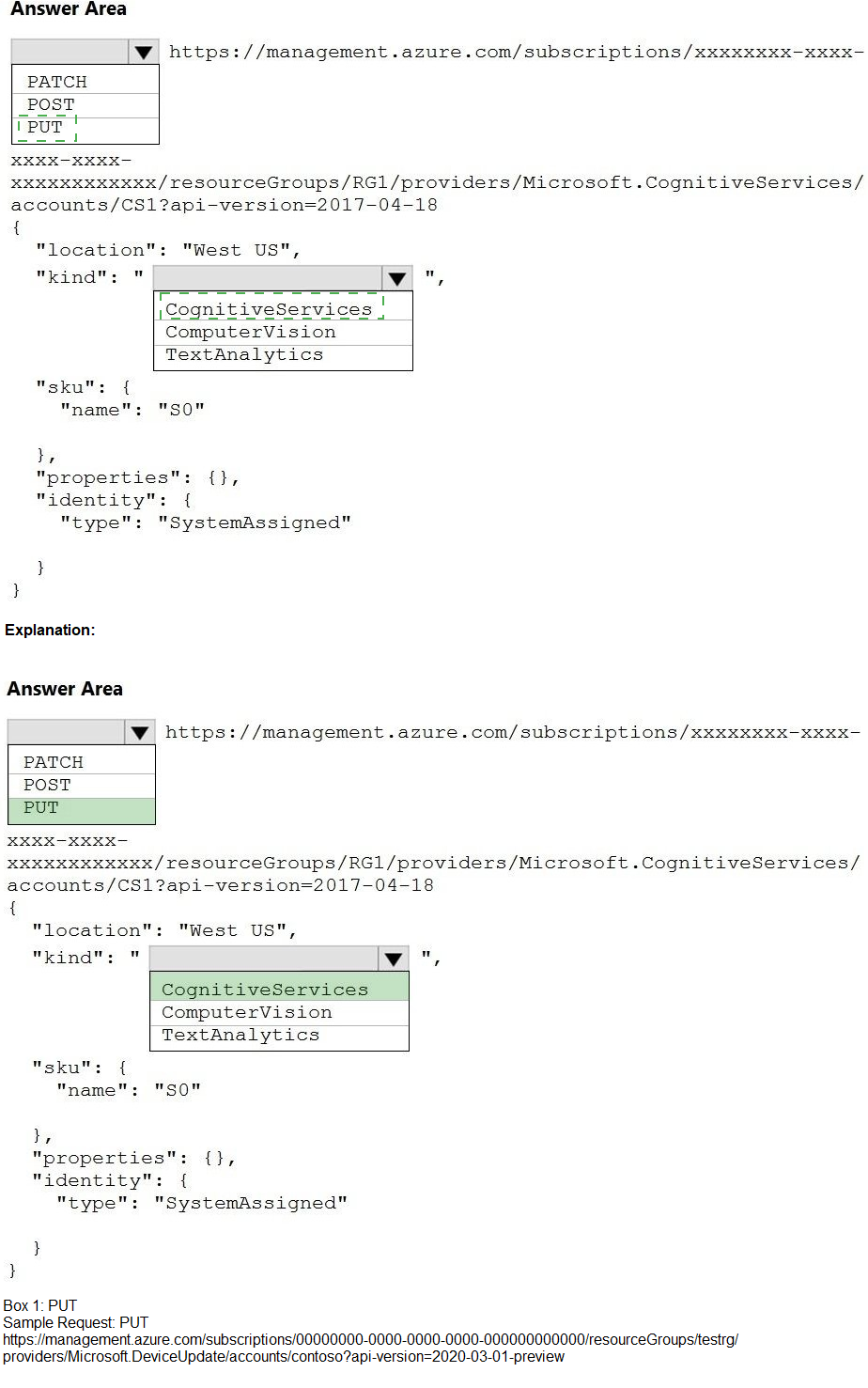
| Page 3 out of 22 Pages |
| Previous |